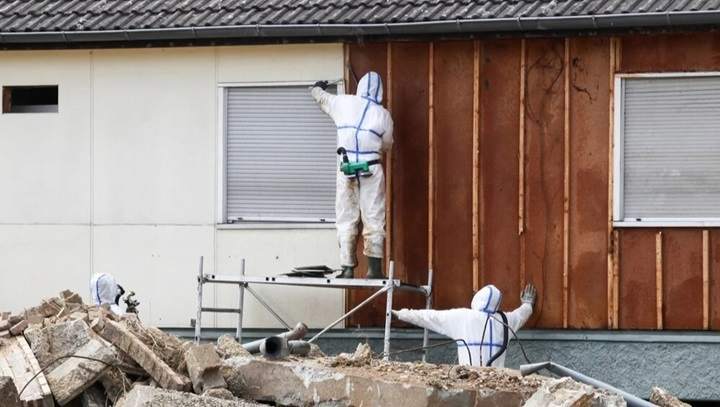Few substances cause as much alarm in home safety as asbestos does. Once revered for its fireproof and durable qualities, asbestos now poses serious health hazards when disturbed. Homeowners needing guidance managing asbestos exposure often turn to professional asbestos removal services for advice on controlling exposure risks to this potentially toxic material.

Table of Contents
What Is Asbestos?
Asbestos is an asbestos mineral known for its heat resistance and durability. Once used widely in construction, insulation, manufacturing, and other fields; now its main uses have largely vanished due to regulatory pressure. “Asbestos” actually refers to six fibrous minerals with Chrysotile being the most popular followed by Amosite and Crocidolite being additional subgroups within it.
Asbestos poses serious health hazards when exposed to air. Longer exposure may cause lung and mesothelioma cancerous growths to form over time – with symptoms appearing years or decades post-exposure.
Understanding Asbestos in the Home
Many homes built before 1980 contain asbestos-containing materials that pose a potential health hazard to occupants. With so much asbestos present in older properties, homeowners must be diligent when encountering common sources like insulation, ceiling tiles, and flooring materials as they could contain dangerous levels of asbestos fibers that must be managed carefully to identify risks and manage risks properly. Homeowners should pay particular attention when encountering sources such as insulation, ceiling tiles, or flooring materials that contain this mineral.
These materials, once revered for their durability and fire resistance, now pose an extreme danger when disturbed, due to the release of hazardous fibers into the air. Homeowners must conduct regular inspections for signs of asbestos, such as crumbling insulation or disintegrating ceiling tiles that indicate potential danger.
Asbestos-containing materials continue to exist in numerous residential structures despite bans in various countries; remaining informed and proactive allows homeowners to effectively protect themselves and their families against asbestos-related risks.
The Science Behind Asbestos Removal
Asbestos removal requires both knowledge of its properties and strict compliance with safety protocols, making professional asbestos removal services invaluable in mitigating exposure risks associated with asbestos. Certified inspectors bring expert knowledge and equipment that enable them to conduct accurate asbestos surveys that identify all asbestos-containing materials throughout a property – this approach ensures no potential hazard goes undetected, thus protecting the health and well-being of occupants of properties with these hazardous materials.
Professional removalists employ stringent safety protocols during their removal processes to limit asbestos fiber release into the environment, from containment measures and cleanup measures through meticulous cleanup protocols – every step is carefully executed to minimize exposure risks posed by asbestos exposure.
Owners who entrust asbestos removal to experienced experts can enjoy peace of mind knowing the process will be carried out safely and effectively to mitigate health hazards associated with asbestos. Adherence to established protocols is of utmost importance when successfully managing asbestos risks in residential settings.
Preventive Measures to Manage Asbestos Exposure
Homeowners play an invaluable role in protecting themselves against asbestos-related risks by taking preventive steps and remaining vigilant. Regular inspections and testing in older properties serve as essential ways of detecting asbestos-containing materials before they present danger to occupants.
Proactive efforts allow homeowners to detect signs of degradation or damage to insulation, ceiling tiles, and flooring materials that might indicate its presence. By remaining alert, through thorough inspections, they can act preemptively against asbestos risks that threaten family health while assuaging risks caused by asbestos-related risks before they become an imminent danger.
Professional guidance and services should always be sought when dealing with asbestos in residential settings since trained experts possess the experience and equipment to perform thorough inspections, identify asbestos-containing materials accurately, devise appropriate management strategies, and implement safe containment/removal protocols that reduce exposure risks. By outsourcing such tasks to qualified experts instead of doing it themselves homeowners can help protect themselves and their families against potentially hazardous health impacts associated with improper handling and create healthier living environments for themselves and their families.
Conclusion
Homeowners concerned with protecting their families’ health continue to face asbestos-related risks in their residential environments. Removal services play a vital role in mitigating them through understanding their science, identifying risks, and seeking professional assistance when necessary; prioritizing safety is also paramount when protecting against asbestos-related illnesses as it helps ensure a healthier living space for generations yet unborn.

![10+ Best Free Image Hosting Sites [2024] Best Free Image Hosting Sites](https://techmaina.com/wp-content/uploads/2021/02/Best-Free-Image-Hosting-Sites-218x150.jpg)
![Get Free Ahrefs Premium Account 2024 [100% Working] Get Free Ahrefs Premium Account](https://techmaina.com/wp-content/uploads/2021/06/Get-Free-Ahrefs-Premium-Account-218x150.png)

![10+ Best Free Image Hosting Sites [2024] Best Free Image Hosting Sites](https://techmaina.com/wp-content/uploads/2021/02/Best-Free-Image-Hosting-Sites-100x70.jpg)
![Roblox Username And Password [2024] Roblox Username And Password](https://techmaina.com/wp-content/uploads/2021/07/Roblox-Username-And-Password-100x70.png)
![Best Free Remote Access Software For Windows [2024] Best Free Remote Access Software For Windows](https://techmaina.com/wp-content/uploads/2021/02/Best-Free-Remote-Access-Software-For-Windows-100x70.jpg)
![Latest Free Roblox Accounts With Robux [2024] Updated Get Latest Free Roblox Accounts With Robux](https://techmaina.com/wp-content/uploads/2021/06/Get-Latest-Free-Roblox-Accounts-With-Robux-100x70.jpg)
